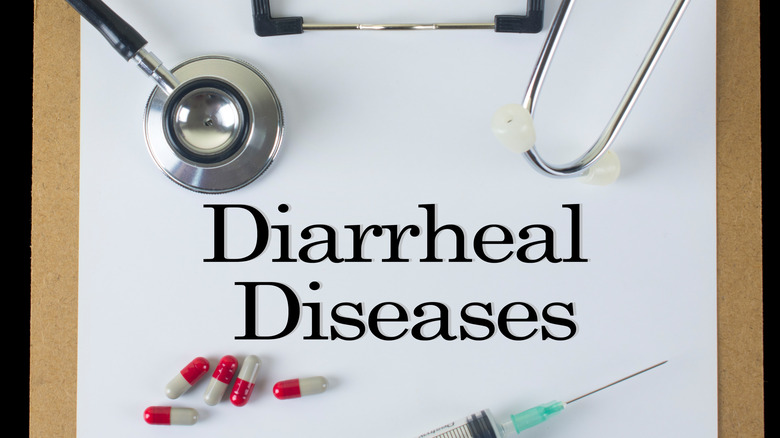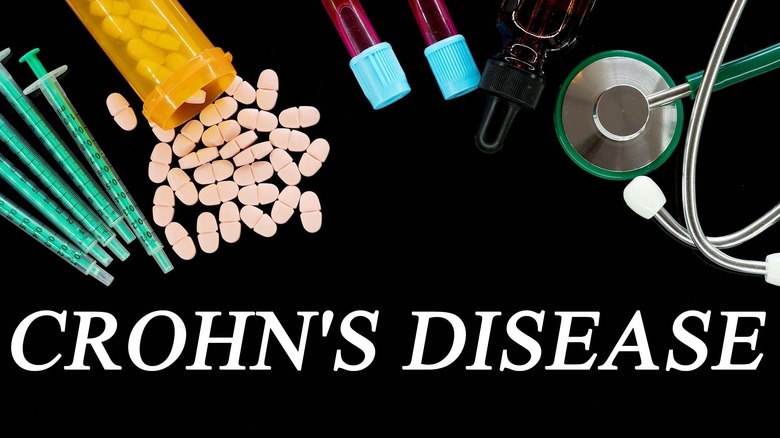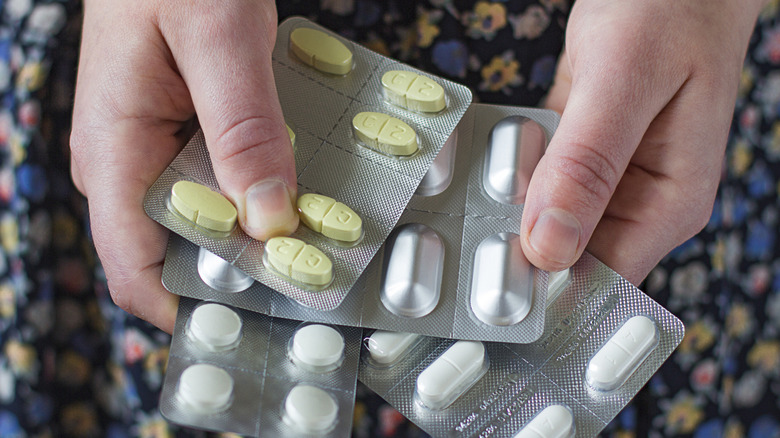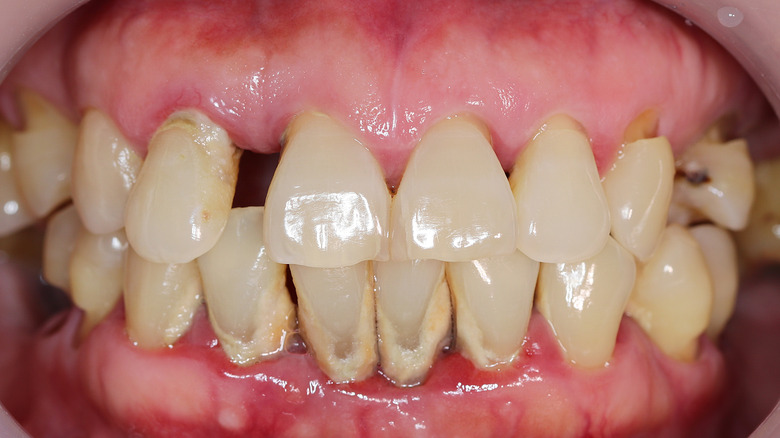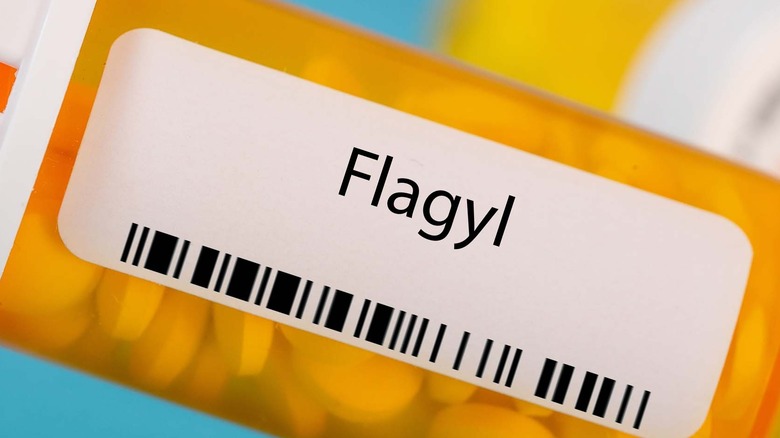Oral Flagyl Explained: Usage, Doses, And Side Effects
Flagyl is the brand name for metronidazole, an antibiotic used to treat certain bacterial and parasitic infections (via the Cleveland Clinic). It is not indicated for viral infections (e.g., the common cold, flu). Flagyl is associated with a variety of adverse effects such as confusion, headache, nausea, vomiting, diarrhea, metallic taste, tingling in the hands or feet, and a change in vaginal discharge. It is contraindicated with alcohol use, and may interact with a number of other medications such as the antacid Tagamet and birth control pills.
Flagyl is most commonly taken by mouth in pill form, though it may also be administered intravenously, vaginally, or rectally (via a 2019 review in the European Review for Medical and Pharmacological Sciences). Oral Flagyl was initially used to treat trichomoniasis, a sexually transmitted disease caused by the parasite Trichomonas vaginalis. It has subsequently been used to treat other parasitic infections such as giardiasis and amebiasis, both of which occur in the intestine and can cause severe diarrhea. Flagyl is also effective against the bacteria Helicobacter pylori and Clostridium difficile, which are associated with ulcers and diarrhea, respectively. It's used to treat bacterial vaginosis, Crohn's disease, and rosacea as well. In addition to treating infections, Flagyl can be used preventatively to reduce the risk of infections occurring after surgery.
Here's what you need to know about oral Flagyl, including its usage, doses, and side effects.
How does Flagyl work?
Flagyl is classified as a "prodrug" because it is inactive until it is converted to an active drug when it is ingested and metabolized in the body (via a review published in a 2012 edition of the Journal of Applied Oral Science). It is actually activated by the pathogens that it treats, specifically anaerobic organisms that don't require oxygen to live and grow. Conversely, there are many streptococci and other bacteria that lack the enzymes needed to convert Flagyl to its active metabolites. These aerobic bacteria (require oxygen) are thus resistant to Flagyl.
Per PDR.net, once Flagyl is taken up by the pathogen, it is chemically altered with the formation of free radical byproducts that are cytotoxic (capable of killing cells). By targeting the DNA of the pathogen, these toxic free radicals generated from the metabolism of Flagyl function as the key mediators of the anti-microbial action of the medication. As they interact with DNA, they block DNA synthesis and cause its degradation. This ultimately leads to the death of the pathogen.
In addition to its antibacterial activity, Flagyl exerts immunosuppressive and anti-inflammatory effects as well. For example, Flagyl is used to treat rosacea, a common inflammatory condition of the skin.
Bacterial infections
Flagyl has been the first line treatment for anaerobic bacterial infections for more than fifty years (via a 2018 study published in Therapeutic Advances in Infectious Disease). Anaerobic (as opposed to aerobic) bacteria thrive and proliferate in the absence of oxygen. For example, these bacteria are normal inhabitants of the mouth and intestine. Along with aerobic bacteria, they are often culprits behind infections in these organs. Consensus guidelines recommend treating the anaerobic bacteria even in cases where the anaerobic bacterium has not yet been identified. Oral (as well as IV) Flagyl is the medication frequently used to treat these infections, as it is effective and well tolerated.
Among the species of anaerobic bacteria that are vulnerable to treatment with Flagyl are Clostridium, Bacteroides, Fusobacterium, and Peptostreptococcus. (via DailyMed). Sites of infection with these bacteria (other than the mouth and intestine) include the skin, liver (abscess), abdomen (peritonitis), bone and joints, central nervous system (meningitis, brain abscess), lower respiratory tract (pneumonia, lung abscess), and the heart (endocarditis). Gynecologic infections (endometritis, tube-ovarian abscess) and septicemia (blood poisoning) are also caused by anaerobic bacteria.
Only infections that are proven or very likely to be caused by these bacteria should be treated with Flagyl. Overprescribing of any antibiotic can lead to increased antibiotic resistance. Antibiotic susceptibility testing for Flagyl is advised when available. This test determines whether Flagyl is effective against a specific bacterium.
Infections caused by parasites
More than half a million children die of diarrheal diseases each year (via a review article published in a 2015 edition of Frontiers in Microbiology). While diarrhea can be caused by bacterial and viral infections, infections caused by parasites are more complex and difficult to eliminate.
Among the many parasites associated with diarrhea are Entamoeba histolytica and Blastocystis hominis, which cause amebiasis and blastocystosis, respectively. Flagyl is the drug of choice for these infections and is also among the preferred medications used to treat giardiasis. Giardiasis is another diarrheal disease and is caused by Giardia lamblia – a parasite that infects roughly 10% of people around the world. Diarrhea can also result from infection with Isospora belli, a parasite mostly prevalent in Africa, Asia, and South America. Flagyl is also capable of curing diarrhea induced by isosporiasis, though other drugs are more effective for this condition.
Flagyl also kills Trichomonas vaginalis, the parasite responsible for the common sexually transmitted disease known as trichomonas (via the Mayo Clinic). While men usually are asymptomatic, women with the infection may have vaginal discharge with a bad odor or may experience discomfort during urination. All sexual partners should be treated to prevent reinfection.
Crohn's disease
Crohn's disease is one of the two major inflammatory bowel diseases (IBD) that cause chronic inflammation in any part of the gastrointestinal tract (via a 2016 review in the World Journal of Gastroenterology). The prevalence of Crohn's disease in the U.S. is 200 out of 100,000 people and increasing.
The population of microorganisms in the intestine, collectively termed the gut microbiota, plays a major role in the inflammatory process in Crohn's disease. People with Crohn's disease often have a reduced diversity of gut bacteria. In genetically susceptible individuals, certain disease-causing bacteria (e.g., Bacteroides fragilis) trigger an abnormal immune response that results in chronic gut inflammation. In contrast, other species of intestinal bacteria (like Lactobacillus) have a protective effect against the development of Crohn's disease and other inflammatory bowel diseases.
The use of Flagyl in the treatment of active Crohn's disease has been shown to decrease disease activity (though modestly), and was found to be particularly effective for disease confined to the colon. Antibiotics such as Flagyl may exert their beneficial effects by changing the population of gut bacteria. Specifically, they encourage the growth of protective bacteria while also killing harmful bacteria such as Bacteroides fragilis. When administered at low doses for three months and tolerated well, Flagyl was also shown to significantly reduce the rate of recurrence of Crohn's disease one year after surgery (via a 2019 study in the Journal of Crohn's and Colitis).
Helicobacter pylori
Helicobacter pylori bacteria are a common cause of disorders involving the gastrointestinal system, including inflammation and ulcers in the lining of the stomach or intestine, as well as stomach cancer (via a 2017 review in Applied Microbiology and Biotechnology). H. pylori is also associated with a certain type of platelet disorder, a form of lymphoma (cancer), and deficiencies of vitamin B12 and iron. While the worldwide prevalence of H. pylori is high (about 50%), it may infect up to 80% of people living in developing countries.
Flagyl has been an integral part of the standard triple therapy for H. pylori infection for many years. The triple therapy consists of a proton-pump inhibitor (acid blocker) combined with two antibiotics: clarithromycin and amoxicillin or Flagyl. However, due to increasing H. pylori resistance to antibiotics, primarily clarithromycin, this triple therapy has become less effective in recent years. Among the alternative strategies for treating H. pylori is bismuth quadruple therapy consisting of a proton-pump inhibitor, the antibiotics tetracycline and Flagyl, and bismuth, another bacteria-killing medication. This quadruple therapy is the treatment of choice in parts of the world where clarithromycin resistance is highly prevalent. It's also used as a backup treatment for H. pylori when the standard triple therapy is ineffective.
Periodontitis
Periodontitis is a serious infection of the gums that causes inflammation and damage to the tissues and bone supporting the teeth (via a 2022 research article published in Frontiers in Oral Health). The development and progression of periodontitis is primarily caused by infection with the bacterium Porphyromonas gingivalis. This pathogen contributes to periodontal biofilms (aggregates of bacteria and other microbes) and, owing to its ability to evade immune defenses, is very persistent. P. gingivalis is associated with progressive bone loss, and may be resistant to conventional treatment via scaling and root planning.
In cases of periodontitis that do not respond to conventional therapy, treatment with Flagyl is an effective alternative, as it eliminates P. gingivalis. In addition to directly killing the bacteria, Flagyl also works by modulating the immune system to reinforce the killing of P. gingivalis by specific immune cells called polymorphonuclear neutrophils (PMN). Flagyl can also be used as a treatment for gingivitis, periodontal disease, and halitosis, as well as a prophylaxis for dental surgery.
Typical dosing for Flagyl
Dosing for Flagyl depends on several factors, including the type of infection and its severity, age, the presence of other medical disorders, and tolerance of the first dose (per Medical News Today).
For bacterial infections, the typical adult dose is 500 milligrams two to four times a day, for up to two weeks. Amebiasis infections are treated with 500 to 750 milligrams of Flagyl given thrice per day for up to 10 days. The protocol for trichomoniasis is two grams taken either as a single dose or as a split dose (one gram taken twice daily). Another option for trichomoniasis is 250 milligrams Flagyl three times a day for one week. Extended-release 750 milligrams tablets for seven days is indicated for the treatment of bacterial vaginosis. Adults aged 65 and older may need lower doses of Flagyl due to greater retention of the drug in the body caused by slower drug metabolism in the liver or kidneys.
Dosages of Flagyl for children are generally based on body weight and assessed by the prescribing physician (via the Mayo Clinic). While immediate-release tablets or capsules can be taken with or without food, extended-release tablets must be swallowed whole on an empty stomach one hour before or two hours after eating. To maintain steady blood levels of the drug, doses must be taken as scheduled. A missed dose should be taken as soon as possible; otherwise, avoid double dosing by skipping the missed dose and resuming your regular schedule.
Side effects of Flagyl
Some common adverse effects of Flagyl are generally not severe enough to require medical attention, notes Healthline. These include nausea, vomiting, diarrhea, constipation, heartburn, abdominal pain, poor appetite, and metallic taste in the mouth. Women may experience yeast infections and vaginal discharge. Though uncommon, several serious side effects affecting the brain and nervous system can occur from taking Flagyl. Some have reported the development of encephalopathy (brain malfunction), which can lead to problems with simple movements such as walking as well as dizziness and impaired speech. Other brain-related effects include seizures, meningitis marked by fever and severe headache, and nerve damage that can cause pain and numbness in the hands or feet.
Another serious effect of Flagyl is neutropenia, a deficiency of infection-fighting immune cells known as neutrophils. Neutropenia can increase vulnerability to new infections. Flagyl has also been linked to a serious skin condition called Stevens-Johnson syndrome. This rare condition can cause painful blisters on the skin, as well as fever and fatigue. These symptoms require emergency medical attention. Any severed allergic reaction to Flagyl (e.g., shortness of breath, tongue or throat swelling) is also a medical emergency.
Oral Flagyl also has a black box warning from the FDA that pertains to the risk of cancer. Some animal studies testing Flagyl resulted in the development of cancer, though the animals were given high doses of Flagyl for an extended period. Based on these studies, Flagyl may be carcinogenic (cancer-causing) in humans.
Interactions with other medications
Disulfiram is a medication used to treat alcohol dependence by causing unpleasant reactions when taken together with alcohol (via Drugs.com). Flagyl should not be taken with disulfiram or within two weeks of discontinuing disulfiram (via Medical News Today). Psychotic reactions (e.g., confusion, hallucinations, and delusion) can occur if the two drugs are taken together.
Other drugs taken with Flagyl may result in increased levels of either medication, thus potentially raising the risk of adverse effects. For example, people on Flagyl therapy who take blood thinners (e.g., Warfarin) may run the risk of bleeding. Concomitant intake of cimetidine — an antihistamine and antacid — with Flagyl may increase levels of Flagyl (along with possible side effects) in the body, whereas the anticonvulsants phenytoin and phenobarbital can decrease levels of Flagyl and potentially diminish its therapeutic effect against the infection.
Lastly, lithium (a psychiatric medication) and busulfan (a chemotherapy drug) are additional medications whose levels in the body should be monitored when taken by people on Flagyl therapy.
Use during pregnancy and breastfeeding
According to Medscape, well-controlled studies to determine whether Flagyl is safe to use during pregnancy are limited. Most human studies investigating exposure to Flagyl during pregnancy have not shown an increased risk of birth defects or infant cancer.
Though unconfirmed, one study reported an elevated risk of cleft lip in newborns of women who took Flagyl during pregnancy. While it is known that Flagyl is transferred across the placenta and reaches the fetus, evidence from animal studies testing the highest recommended dose shows no harm to the fetus. However, there is no knowledge of whether it has any impact on the development of the human fetus. Ultimately, the physician should weigh the potential risks against the potential benefits when prescribing Flagyl during pregnancy.
Flagyl passes into human milk at concentrations closely matching levels found in the blood. Due to the potential increased risk of cancer based on animal studies, women should discontinue breastfeeding if they must stay on the medication. Otherwise, mothers can pump and discard breast milk when taking Flagyl, as well as within 24 hours after stopping the medication. Stored breast milk or formula can then be fed to the baby.
Flagyl and alcohol use
Drinking an alcoholic beverage while taking Flagyl is particularly risky, notes Healthline. Products containing alcohol should be avoided not only while taking Flagyl, but also during the three days following completion of the treatment. Labels should be carefully checked for the presence of any amount of alcohol. Even the small amount of alcohol found in mouthwashes should be avoided. Other somewhat unexpected sources of alcohol include cough medicines, breath strips, shaving products, fragrances, hair sprays, insect sprays, hand sanitizers, and body washes.
Mixing Flagyl with alcohol can cause a chemical reaction that is very similar to the reaction that occurs from the use of disulfiram, a medication used to discourage alcohol consumption (via a 2019 study published in The Journal of Pediatric Pharmacology and Therapeutics). Normally, the metabolism of alcohol involves its conversion to a toxic by-product (acetaldehyde) that is then rapidly detoxified and disposed of. However, simultaneous use of Flagyl and alcohol inhibits the enzyme that detoxifies alcohol, resulting in the accumulation of poisonous acetaldehyde in the body. This can subsequently lead to adverse effects such as nausea, vomiting, abdominal cramps, facial flushing, rapid heartbeat, severe headaches, and fainting.



